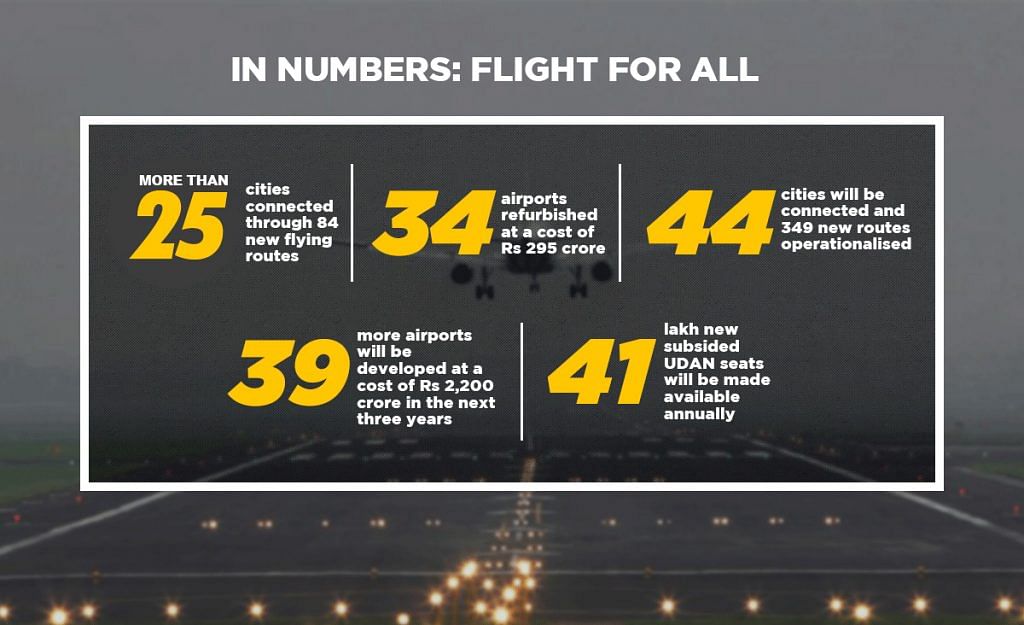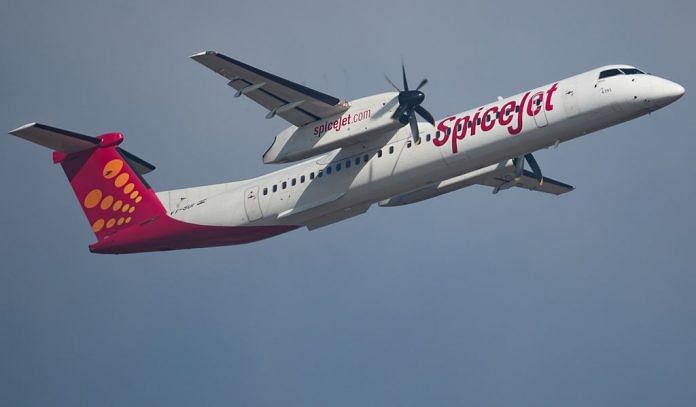UDAN, launched in 2016, has connected 29 new destinations. By the time phase two ends, 73 cities will be linked, doubling India’s air-connectivity.
New Delhi: Before 2016, India had 75 operational airports, built over a century. In the year-and-a-half since, that number has increased to 100.
The boost in connectivity is thanks to UDAN, a government scheme launched in October 2016, that has linked 25 smaller cities and towns by air.
UDAN or ‘Ude Desh Ka Aam Nagrik’ is aimed at making flying affordable and accessible for the masses in tier-II and tier-III cities. It has introduced 84 new flying routes and helped redevelop 34 airports.
How the idea took off
Under UDAN, for the first time, the government reached out to private airline operators, asking them to identify new routes they would be willing to fly, with subsidy from the government.
A part of this subsidy was made possible by convincing state governments to participate in the scheme and slash the VAT paid by airlines. The government also made the scheme lucrative by providing airlines the exclusive right to fly the routes they had chosen.
UDAN began with the civil aviation ministry offering over 400 airstrips to airlines and asking them to decide which air-route they want to bid on. It thus relied on a market-based mechanism where airlines decided routes based on their own research and survey of the market.
The airlines were then asked to bid for these routes by citing the amount of subsidy or viability gap funding (VGF) they would require per seat to operate an UDAN flight. Whichever airline asked for the least VGF per seat won the bid. The subsidy forms an important part of the scheme since the routes are new and, in most cases, would become financially viable only over a period of time.
“This way the risk associated with new routes is shouldered by the government and spread between them and the operators,” said Deepraj Sirohi, head of operations at Sky One Airways, which will provide helicopter services to certain areas in Arunachal Pradesh and Assam under UDAN.
“Opening up of new markets can only happen through hand-holding,” he said.
According to the ministry’s estimate, the VGF will cost the government about Rs 895 crore per year. The subsidy can be anything between Rs 380 and Rs 5,370 per seat, depending of the length of the flight.
About Rs 500 crore of the VGF is funded through the dividend share of the Airports Authority of India. The government funds the rest of this subsidy by charging non-UDAN fliers more on metro routes. For instance, a commuter flying to Mumbai from Delhi will have to pay Rs 50 more per seat, which translates into about Rs 5,000 per flight, said a source in the civil aviation ministry.

However, VGF isn’t the only thing that made UDAN a reality.
According to a senior official in the civil aviation ministry, the scheme required “painstaking” MoUs with state governments.
A significant move was to convince states to slash the VAT on fuel to 1 per cent, which enabled a 10 per cent reduction in operating costs.
“ATF (airline turbine fuel) typically constitutes 30-40 per cent of operational cost of an airline and VAT accounts for around 20-40 per cent of the cost of operations,” said the official.
“Under UDAN, VAT has now been reduced to 1 per cent and so, cost reduction ranging from 6-16 per cent (average 10 per cent) can be estimated for the airline industry,” the official added.
Apart from support in the form of VGF, the ministry arranged for UDAN flights to not pay any landing or take-off charges.
The biggest incentive for airlines, however, has been a three-year exclusivity over the routes. For instance, if an airline wins a bid for a regional route, it will have the exclusive right to fly that route for the next three years.
“Once airlines are able to develop the market, they get to single-handedly use the market,” said Kuljit Singh, a partner at Ernst & Young, a business consulting firm.
For an operator, routes have played an important factor in determining success under UDAN.
A senior official at SpiceJet told ThePrint that the airline didn’t seek any VGF from the government since it was convinced about the commercially viability of its routes.
The scheme
In the coming years, the scheme, which has so far been divided into two phases, will be able to connect a total of 73 cities through 433 new flying routes. A third phase, UDAN-3, is also in the pipeline.
Since aim of the scheme is to subsidise air travel, an UDAN flight must keep 50 per cent of its seats, or a maximum of 40 seats, at a lowered price. The cap for such seats is Rs 2,500 for an hour-long flight on an aircraft or a 30-minute chopper ride.
In the next three years, 39 more airports will be developed at a cost of Rs 2,200 crore. And once all the routes start functioning, a total of 41 lakh subsidised seats will be made available annually.
Small towns on aviation map
UDAN has not only introduced flying to people in aviation-dark areas but has also made small towns accessible for Indians residing elsewhere.
According to Subhash Goyal, chairman of STIC Travels, the flight from Adampur Airport in Jalandhar to Delhi, for example, is already being used extensively by NRIs as it opens access to the Doaba region of Punjab. Even in a relatively small state like Punjab, cities such as Bhatinda, Pathankot and Jalandhar will now be accessible from Delhi via air.
Minister of State for Civil Aviation Jayant Sinha said UDAN will be able to connect people in remote areas of the country.
“Arunachal Pradesh didn’t have an airport. Now it has one in Pasighat. Pakyong in Sikkim is going to be commissioned and is going to be UDAN airport,” Sinha said.
“We are also connecting the Himalayan areas through helicopter services,” he said.
The scheme is instrumental in introducing flying to a new set of people in small towns.
“At the heart of the scheme lies the message that if a person wants to get out of a city, he has the ability to do so quickly and that the government had created a new way to access the city,” said a ministry official.
According to Sinha, UDAN enables a lot of ‘essential travel’ required for medical services and by government officials, students and NRIs going to their hometowns among others.
Experts say UDAN will take aviation to the hinterland of India, to those who have no exposure and help in the creation of essential and emergency services.
“An example of this is air-ambulance. In case of medical services, even if people have money they don’t have access. This will connect them to the mainland,” said Neerja Singh, director, transport infrastructure at FICCI.
Even consumers seem to have responded well to the scheme if occupancy rates are anything to go by. According to the ministry official, occupancy rates on UDAN flights range from 70 to 90 per cent.
“So far, consumer response has been very good, with flights experiencing an occupancy rate of 75 per cent,” said Senthil Raja, commercial head at Turbo Megha, whose Trujet flights are operating on 18 UDAN routes, mostly connecting tier-II cities in south India.
Aviation’s big change
UDAN may not directly accelerate growth in the aviation sector or bring in large number of passengers to the sector, but stakeholders across the spectrum are confident that the scheme is set to bring immense change.
Airline operators have already begun preparations to meet the needs of the new scheme. Both Indigo and SpiceJet have reportedly made large orders of planes suited to the regional market.
Indigo is going to buy 50 ATR 72-600 planes, which have a seating capacity of 70 people, to make its mark in the regional market.
SpiceJet too has signed a deal with Canadian company Bombardier to purchase 50 Q400 aircraft, each having a seating capacity for 78 people.
“What UDAN does is bring in new passengers, those who were in aviation-dark areas to the market,” said the ministry official.
Bringing in new passengers can help airlines adopt a “hub- and-spoke model”, say experts.
In hub- and-spoke, airline operators make busy airports such as those in metro cities their hubs. The airlines then develop regional routes, so that they bring more traffic to their hubs.
According to Ashwini Kakkar, vice-chairman of Mercury Travels, both Indigo and Spicejet are now “very keen” on developing hub-and-spoke models.
“When you add new nodes to a system, the system becomes exponentially more attractive and brings in more traffic,” explained Sinha.
Even if a route like Jamshedpur-Kolkata does not make as much money as it should, it is bringing 30 passengers more to Kolkata. This could fill all the seats on a Kolkata–Delhi flight, said the MoCA official.
While the first round of route bidding received a lukewarm response, India’s biggest carriers such as Indigo and SpiceJet participated significantly in the second round of bids under UDAN-2.
Smaller and regional operators also see opportunity in the scheme.
“We are looking to build hubs at other regions of the country where we can have a mix of UDAN and regular operations,” said Senthil Raja of Turbo Megha.
Sirohi of Skyone said they participated in the scheme because UDAN served the perfect opportunity to “penetrate the market”, despite initial regulatory and licensing challenges.
Sinha clarified that the government has worked closely to bring in small operators into the market and ease licensing requirements for them.




wastage of time and money. You are planning to run an Airport as a bus-stand. only metros and capital cities of states should have better well-equipped airports and those cities should have well-connected highway connectivity to other cities of that state. opening an airport in every village or town is not feasible and it is wastage of public money. Airlines are also not keeping to start flights to such small towns due to losses.